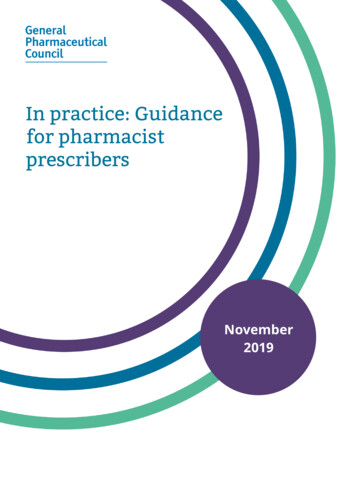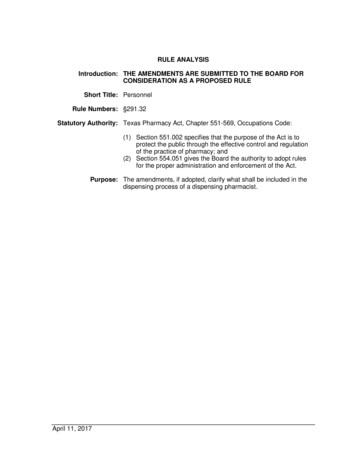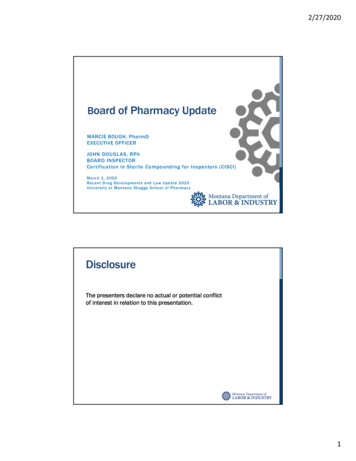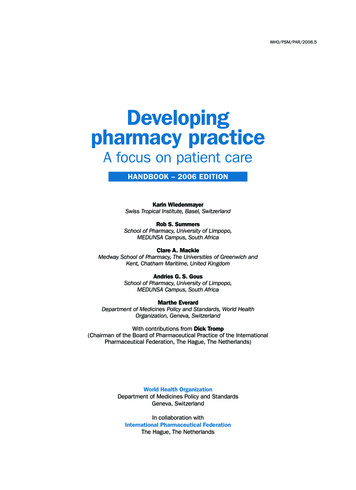
Transcription
In practice: Guidancefor pharmacistprescribersNovember2019
The text of this document (but not the logo and branding) may be reproduced free of charge in anyformat or medium, as long as it is reproduced accurately and not in a misleading context. Thismaterial must be acknowledged as General Pharmaceutical Council copyright and the documenttitle specified. If we have quoted third party material, you must get permission from the copyrightholder.Contact us at communications@pharmacyregulation.org if you would like a copy of thedocument in another format (for example, in larger type or in a different language). General Pharmaceutical Council 2019
ContentsAbout this guidance . 4Pharmacist prescribing . 61. Taking responsibility for prescribing safely . 92. Keeping up to date and prescribing within your level of competence . 143. Working in partnership with other healthcare professionals and people seekingcare . 164. Prescribing considerations and clinical judgement . 195. Raising concerns . 256. Information for employers of pharmacist prescribers . 26Questions to ask yourself. 28Other sources of information . 29
November 2019About thisguidanceThe General PharmaceuticalCouncil is the regulator forpharmacists, pharmacytechnicians and registeredpharmacies in England,Scotland and Wales. As part ofour role, we set the standardsthat pharmacy professionalshave to meet throughout theircareers.In applying this guidance in practice,pharmacist prescribers must be ableto justify their decisions and use theirprofessional judgement in theperson’s best interests.This guidance should be applied alongside thestandards for pharmacy professionals, whichall pharmacy professionals must meet.It should also be applied alongside ourstandards for registered pharmacies. Allpharmacy owners are responsible for meetingthese, to ensure the safe and effective provisionof pharmacy services from the registeredpharmacy. When pharmacy owners providepharmacy services at a distance, including onthe internet, they should also apply ourguidance for registered pharmaciesproviding services at a distance, including onthe internet.Pharmacist prescribers should also keep to theother relevant standards and guidance thatapply to their place of work and role. These maybe, for example, from the Care QualityCommission, Healthcare Inspectorate Wales,Healthcare Improvement Scotland or theAdvertising Standards Authority.This guidance cannot cover every situation anddoes not give legal advice, as all pharmacyprofessionals must use their professionaljudgement and keep to the relevant laws.4In practice: Guidance for pharmacist prescribers
It gives guidance to pharmacist prescribers inapplying the standards when prescribing. Theguidance applies whatever setting pharmacistprescribers work in. It sets out the key areaspharmacist prescribers should consider whenapplying the standards to their prescribingpractice.and the RPS competency framework for allprescribers please see ‘Other sources ofinformation’ at the end of this document.Not following this guidance, or not taking theappropriate steps to ensure safe prescribing,could result in the registration of the pharmacistprescriber being at risk.We want this guidance to support theappropriate and effective provision ofpharmaceutical care and medicines, whichkeeps to the law and meets our standards. Webelieve this guidance will be helpful for otherorganisations who employ pharmacistprescribers or provide pharmacy prescribingservices across a range of settings.All pharmacy professionals should make surethey are familiar with the areas covered in thisguidance and understand their ownresponsibilities in relation to prescribers.This guidance should also be read alongside anyrelevant regulatory and NHS documents forEngland, Scotland and Wales, and any relevantguidance published by other organisations,including professional leadership bodies andother regulators.We have a range of guidance on our websiteto help pharmacy professionals apply ourstandards. For more information on writingprescriptions, using electronic prescriptions,In practice: Guidance for pharmacist prescribers5
November 2019PharmacistprescribingPharmacist prescribers play a vital role in thedelivery of high-quality healthcare services andin the improvement of person-centred careacross many healthcare sectors in England,Scotland and Wales. They are well placed to usetheir knowledge of medicines, and their skills asprescribers, in the existing and various newroles which are being developed and integratedinto care models. Pharmacist prescribers areresponsible for creating a culture of personcentred professionalism wherever they work,and for ensuring prescribing itself andprescribing services are delivered safely andeffectively.A pharmacist prescriber may be a pharmacistsupplementary prescriber (PSP) or a pharmacistindependent prescriber (PIP). Both canprescribe, supply and administer medicines andmedical devices.In this guidance we use the term ‘pharmacistprescriber’ to include both supplementaryprescribers and independent prescribers, asthey can both work in the same settings. Butwhere supplementary prescribers cannotprescribe certain medicines we have highlightedthis.What do we mean by a ‘supplementaryprescriber’?A supplementary prescriber works with amedical or dental practitioner within aspecific clinical management plan (CMP)but does not prescribe independently. Thelaw sets out what the CMP must include,and the limitations on what the PSP canprescribe and under what circumstances. Asupplementary prescriber cannot prescribeveterinary medicines or non-surgicalcosmetic products. A PSP may become aPIP through further training and byconverting their qualification. They canthen work as both a PSP and a PIP.What do we mean by a ‘pharmacistindependent prescriber’?A pharmacist independent prescriber is apharmacist who has completed therelevant approved education and trainingto add an annotation to their entry in theregister. The GPhC sets standards for theeducation and training of pharmacists tobecome a PIP.A PIP may prescribe all medicinesindependently for any condition withintheir scope of practice and clinicalcompetence. The exceptions to this are thethree controlled drugs for the treatment ofaddiction (cocaine, dipipanone anddiamorphine), and unlicensed cannabisbased medicinal products (CBMPs).6In practice: Guidance for pharmacist prescribers
A change in the law in November 2018 madecannabis and certain cannabis-basedmedicinal products (CBMPs) Schedule 2controlled drugs under the Misuse of DrugsRegulations 2001. However, unlicensedCBMPs can be prescribed only by a specialistdoctor registered on the General MedicalCouncil (GMC) Specialist Register. Once asubstance receives a marketingauthorisation, this restriction no longerapplies and it can be prescribed by anyprescriber. Pharmacist independentprescribers can also prescribe certainprescription-only veterinary medicines, inline with the present Veterinary MedicinesRegulations.A PIP can act as both a supplementary andindependent prescriber. For example, if aPIP is working in a new area of competencethey may decide to act under a clinicalmanagement plan as a supplementaryprescriber, while still being confident toprescribe in another area of competence asan independent prescriber.In practice: Guidance for pharmacist prescribersPrescribing in contextPrescribing can take place in different ways. Itmay involve the pharmacist prescriber makingan independent decision, after a diagnosis, tosupply or refuse to supply a prescription-onlymedicine or medical device on prescription. Itmay also include giving advice and informationon the person’s medicines. This could happenacross all settings, but usually the prescribingprocess is complex and is about more than justwriting a prescription.However, a PIP is responsible for andaccountable for the clinical assessment andmanagement of people (with diagnosed orundiagnosed conditions), without needing toconsult another prescriber. They are alsoresponsible for the prescribing decisions theymake.Pharmacist prescribers in community pharmacymay prescribe for people who walk in, or havebeen referred, for a range of minor conditionsand short-term illnesses as well as for somelong-term conditions. Some pharmacistprescribers work remotely and carry outconsultations on the phone from GP practices,or prescribe online. More and more often,pharmacy owners are employing or contractingwith a pharmacist prescriber or service providerto provide online prescribing services.Pharmacist prescribers may also prescribe incommunity health teams, prisons, the armedforces, care homes, for travel and othervaccinations, and in private cosmetic clinics.7
November 2019In hospitals, care homes and GP surgeriespharmacist prescribers make the best use ofmedicines in treating long-term conditions,diagnosing and treating acute illness andmonitoring the results of treatment. Whenpharmacist prescribers carry out medicationreviews for people taking a large number ofmedicines, this often leads to a shared decision,in partnership with the person and themultidisciplinary team, to stop unnecessarymedicines being prescribed (called‘deprescribing’). This may include reviews forpeople in care and residential homes and inother care settings.In this case the prescribing is not their soleresponsibility.Pharmacist prescribers, as part of their role,may also: clarify and amend prescriptions,either electronically or manually; make dosageadjustments; deal with referrals and testrequests; and carry out follow-up care.Pharmacist prescribers may prescribe forpeople when they are admitted to hospital forexisting conditions diagnosed, for example, bytheir GP. They may also write prescriptionswhen the person is discharged. There may besituations when the pharmacist prescriber maynot be competent to diagnose patients with aparticular condition. So, to ensure continuity ofcare they may continue to prescribe aprescription made by another clinician.Working as part of a multidisciplinary team(MDT) is key to improved care and patientsafety. Pharmacist prescribers are an importantpart of MDTs, working alongside otherhealthcare professionals to jointly agree on aperson’s care. For example, on a ward round,the pharmacist prescriber may prescribe underthe direct guidance or advice of anotherprescriber such as a consultant or specialist.8In practice: Guidance for pharmacist prescribers
1. Taking responsibility for prescribingsafelyPeople receive safe, effective and personcentred care when pharmacy professionalstreat every person as an individual with theirown values, needs and concerns.Pharmacist prescribers are responsible andaccountable for their decisions and actions. Thiswill include when they prescribe or deprescribe,and for their prescribing decisions. To improvepatient safety and to keep risks to patients aslow as possible, pharmacist prescribers mustmake sure their prescribing is evidence-based,safe and appropriate. Any prescribing decisionsmust be made in partnership with the personbeing assessed, to make sure the care meetstheir needs and that the pharmacist prescriberhas consent to prescribe, when this isappropriate. In hospitals there are situationswhere this may not always be possible, as thereis ‘implied’ consent when a person is admittedto hospital. This would include access to theperson’s medical notes.Pharmacist prescribers must use theirprofessional judgement, so that they act in theperson’s best interests and prescribe only themedicines they know to be safe and effective forthe condition they are treating.Pharmacist prescribers must communicateeffectively with the person to: understand their needs make sure there is a genuine clinical needfor treatmentIn practice: Guidance for pharmacist prescribers assess whether the person has the capacityto make a decision about their care orconsent. There may be cases when theperson may lack capacity either physically(for example, because they areunconscious), or because they are unable tomake decisions about their care. come to a shared decision about the carethey provide. They must do this by gettingall the relevant information from theperson, and giving the person – and carerwhenever appropriate – all the relevantinformation in a way they can understand,so they can make an informed decision andchoice. make sure the person is aware of any risksinvolved in their treatment and the risks ofany reasonable alternative or differenttreatment optionFor more information on consent and capacity,please see our In practice – guidance onconsent, June 2018. This includes informationabout individuals with powers of attorney thatcover health and welfare decisions (England,Wales and Scotland), for example: the Lasting Power of Attorney (LPA) inEngland and Wales guardians with welfare powers in ScotlandPharmacy professionals must take responsibilityfor making sure person-centred care is notcompromised by their own personal values andbeliefs. People receive safe and effective care9
November 2019when professionals recognise and valuediversity and respect cultural differences. Allpharmacy professionals, including pharmacistprescribers, have the right to practise in linewith their religion, personal values and beliefsas long as they act in line with equalities andhuman rights law and make sure that personcentred care is not compromised.For more information please see In practice:Guidance on religion, personal values andbeliefs.To safeguard people, particularly children andvulnerable adults, it is important thatpharmacist prescribers know who to refer to,and act when necessary. This is particularlyimportant when prescribing at a distance.Pharmacist prescribers must make sureincentives and targets do not compromise theirprofessional judgement. They must make surethe care they provide reflects the needs of theperson and does not compromise the health,safety and wellbeing of patients and the public.For more information on incentives and targetsplease see our ‘Other sources of information’ atthe end of this document.When prescribing, pharmacyprofessionals should consider thefollowing three areas:1. Having all the necessary information toprescribe safelyTo prescribe safely, it is important to be able tohave access to a person’s medical records.However, access may not be possible or may belimited, and there are potential risks inprescribing without these records. Pharmacistprescribers should assess whether they havesufficient information and knowledge of theperson’s health and medical history to make anassessment of the condition. This includes usingmedical records such as the summary carerecord (SCR) (in England), the emergency caresummary (in Scotland) or the Welsh GPrecord, when these are available. Pharmacistprescribers should use other sources ofinformation, such as recent hospital dischargeletters, test results and clinic letters to get aclear understanding of the person’s condition,so they are able to reduce any risks in decidingwhether they can prescribe safely. They shouldbe able to demonstrate that they have assessedthe risks when making a professionaljudgement, for example by keeping a record oftheir reasons to prescribe in thesecircumstances. (For more information pleasesee Section 3.1.)What do we mean by medical history?This may include finding out about: their family and social history recent surgery any previous adverse reactions or allergiesto medicines allergies to flavouring and food products10In practice: Guidance for pharmacist prescribers
recent use of other medicines, including:regular medicines, acute medicines (forexample, short-course antibiotics), overthe-counter medicines, herbal medicines,alternative medicines and medicinesbought online other medicines and medical conditionswhich may or may not be on their record(for example, chemotherapy, medicinesprescribed for mental health and homecare medicines)They should encourage the person to be openabout the way they take their medicines, andabout whether they have taken prescribedmedicines in the way they were prescribed.They should assess the risks of prescribing: for different groups of patients (forexample babies, children, young people,women and girls of child-bearing age,pregnant women and women who arebreastfeeding, older people) and peoplewith reduced kidney or liver function andthe conditions caused by this for people who share protectedcharacteristics certain categories of medicines (forexample, controlled drugs) andprescribing in certain circumstances prescribing in different pharmacy settingsand also, for: people seeking medicines or treatmentinappropriately1 requests for large quantities of, orfrequent requests for, medicines –particularly ones that may be abused,overused or misusedand do everything they can to make thoserisks as low as possible2. Prescribe safelyPharmacist prescribers must prescribe onlywithin the limits of their knowledge, skills andarea of competence. They should: fully assess the person and carry out anexamination, when it is necessary, in anappropriate environment which ensures theperson’s privacy and confidentiality prescribe in line with clinical1, national andlocal guidelines – which are evidence-based– whenever possible when prescribing and reviewing theperson’s medicines, communicate anddocument any changes to the person’smedical record as soon as possible, toimprove patient safety, care and continuityof care. This should include:– a record of discussions, especially whenprescribing is outside the nationalguidelines or is for an unlicensed or ‘offlabel’ medicine– the reasons for their prescribingdecisions, andNICE (England), Scottish Medicines Consortiumand Health Improvement Scotland,Department for Health, Social Services andPublic Safety (Northern Ireland), All WalesMedicines Strategy Group (Wales) and medicalcolleges and other authoritative sourcesIn practice: Guidance for pharmacist prescribers11
November 2019– arrangements for follow-up andmonitoring explain their reasons for not prescribing,and any other options available to theperson when they consider prescribing tobe inappropriate refer the person to an appropriatehealthcare professional when they needfurther examination or assessment be able to show that all prescribingarrangements are transparent, and thatthere is no conflict of interest such as:– prescription direction– restricting a person’s choice, or– unduly influencing or misleading,deliberately or by mistake, peoplewanting prescribing services make prescribing decisions based on theneeds of the person and not because ofcommercial interests or pressure frompeople, colleagues, employers orpharmaceutical companies consider the impact of their prescribing onthe person they are prescribing for consider when it may be appropriate towithhold medicines, deprescribe or alter aprescribed dose review prescriptions with repeats, andrepeat prescriptions, as part of the NHSrepeat dispensing service (England andWales), the Medicines: Care and Review(MCR) (Scotland), or when reviewing aperson’s medicines. They should checkwhether there have been any changes inthe person’s circumstances, such as a12hospital stay, or changes to their medicinesfollowing a hospital or home visit in the case of an unlicensed or ‘off-label’medicine, make sure there is sufficientevidence and experience of its safety andeffectiveness, and of the appropriateness ofits use to meet the needs of the person.Some medicines are routinely used outsidethe terms of their licence, for example inpaediatrics and palliative careWhat do we mean by ‘unlicensed’ or ‘off label’ medicines?The term ‘unlicensed medicine’ is used todescribe medicines which have no licence foruse in the UK.‘Off-label’ medicines are ones that are licensedbut are being used outside the terms of theirUK licence.Prescribing an unlicensed or ‘off-label’medicine may be necessary to meet thepatient’s needs. For example, when: only an ‘adult’ formulation is licensed, butthe patient is a child, or the suitably licensed medicine is notavailable because of medicines shortagesIt may not always be appropriate to explainthat the medicine is unlicensed: for example,in emergencies, or if it is likely to causedistress to the patient or the carer. For moreinformation on unlicensed medicines pleasesee our guidance for registered pharmaciespreparing unlicensed medicines August2018 and ‘Other sources of information’ at theend of this document.In practice: Guidance for pharmacist prescribers
3. Follow-upThe pharmacist prescriber should: provide relevant information – includingpatient information leaflets – in a way theperson can understand, and check theyhave understood thisthe pharmacist prescriber to make sure noserious conditions are missed (this is called‘safety netting’) decide what monitoring is needed followingthe prescribing activity and allow the personaccess to this monitoring to ensurecontinuity of care. This could be, forexample, by giving them any relevant formsif the medicine prescribed needs followingup by therapeutic drug monitoring use reporting mechanisms for suspectedadverse drug reactions (ADRs), such as theYellow Card Reporting Scheme, and makesure the person knows how to report ADRs use reporting mechanisms for suspectedpatient safety incidents: the NHS NationalReporting and Learning System (NRLS)(England and Wales), and local reportingsystems such as NHS Scotland regionalhealth boards take action when there is a need for urgentreferral to another healthcare professional make sure the person seeking care knowswho to contact if they have any questions orconcerns plan appropriate follow-up reviews thatmeet the needs of the person seeking care assess and monitor the outcome of theprescribing activity to make sure safe andeffective care is provided tell the person that if their condition getsworse, or there are any new symptoms orchanges in their condition, to come back toIn practice: Guidance for pharmacist prescribers13
November 20192. Keeping up to date and prescribingwithin your level of competencePharmacist prescribers can prescribe in manydifferent clinical and therapeutic areas, either asa specialist or a generalist. As these rolescontinue to develop and expand, pharmacistprescribers must maintain, develop and use theprofessional knowledge and skills relevant totheir role and prescribing area, to make sure theperson receives safe, appropriate and up-todate care. They should use the RoyalPharmaceutical Society A Competencyframework for all prescribers , the GPhCStandards of initial education and trainingfor pharmacist prescribers and the learningoutcomes, as well as other reference sources2,to help identify any gaps in their knowledge.Whatever the person’s condition and themedicines available to manage their health care,pharmacist prescribers must prescribe onlywithin the limits of their knowledge, skills andclinical competence. They must: maintain the competencies specific to theirrole as a prescriber and the scope of theirpractice, and reflect on the application of their knowledgeand skills to keep themselves up to datePharmacist prescribers can get support from,and give support to, their peers. This could be,for example, when working in amultidisciplinary team which helps them tocommunicate, learn and develop alongsideother healthcare professionals. This may alsoinclude having a close working relationship withtheir medical supervisor or mentor afterqualifying.When a person’s condition or the medicinesprescribed are outside a prescribingpharmacist’s scope of practice, they mustconsider the person’s best interests and decidewhether or not they have the competence toprescribe. If they are not competent toprescribe they must refer the person to anotherappropriate prescriber.When returning to prescribing practice after abreak, or when prescribing in a different orextra clinical area, pharmacist prescribersshould undertake any additional training theyneed. This may include, for example, completingthe CPPE return to prescribing course , workshadowing or having work experience in thenew prescribing area. Pharmacist prescribersshould also be familiar with the relevantresources, and make sure that they arecompetent, for example using the RPScompetency framework to demonstrate theircompetence when prescribing in a new area.2MHRA drug safety updates, NHS CentralAlerting System, the National Institute forHealth and Clinical Excellence (NICE) Medicinesand prescribing, the electronic MedicinesCompendium, patient information leaflets(PILs), British National Formulary (BNF) andBritish National Formulary for Children (BNFC),local formularies and clinical guidelines.14In practice: Guidance for pharmacist prescribers
Pharmacist prescribers should record theactivities they have undertaken, for example bykeeping a portfolio with evidence of supervisedpractice areas and any training andassessments.Pharmacist prescribers must make sure theyare competent in the new area of prescribing.They must also check that they are covered bytheir professional indemnity insurer for any newor different prescribing roles they undertake,and must review their cover regularly to makesure of this.For more information on a portfolio of evidencewhen returning to practice, please see thereturning to the register section of ourwebsite.prescribing and reflect on any feedback, errorsor complaints received.Pharmacist prescribers may work outside NHSsettings and where clinical governance systemsmay be different, or not applied in the sameway. If so, they are responsible forunderstanding the governance arrangementsthey work in to make sure they are competentto practise.For more information on training please see‘Other sources of information’ at the end of thisdocument and accredited courses forindependent prescriber training on ourwebsite.Pharmacist prescribers should make sure thatsome of their revalidation records directlyaddress their role as a pharmacist prescriber.This includes keeping up to date with relevantchanges in the law, as well as in the therapeuticareas in which they prescribe. Pharmacistprescribers should use the GPhC’s revalidationframework to plan and to demonstrate thatthey stay up to date with current guidelineswhen prescribing.To continually improve their prescribing skillsand the care they give, pharmacist prescribersshould get another person to regularly auditand monitor their prescribing. This may includea peer review focusing on prescribing. Thiswould review the clinical outcomes of theirIn practice: Guidance for pharmacist prescribers15
November 20193. Working in partnership with otherhealthcare professionals and peopleseeking carePharmacist prescribers must communicateeffectively, and work in partnership with otherhealth professionals and people seeking care, todeliver safe and effective care.If someone’s gender identity is different to whattheir records say, pharmacist prescribers shouldcommunicate in a way that is person-centredand with respect.They must be open and honest with the personseeking care and the people they prescribe for.They should make sure people know they areprescribing as a pharmacist prescriber, as partof either an NHS or private arrangement, andabout any charges that apply.Pharmacist prescribers must ask the person forconsent to access their medical records, or toget other reliable information about theperson’s health and medicines from theirregular prescriber if they have one. To ensureperson-centred care, they must give clearinformation, so that the person receiving carecan make an informed decision, and mustdiscuss other available options when it is notappropriate to prescribe. They should make arecord of all decisions, including when theydecide not to issue a prescription and thereasons why.Pharmacist prescribers must make sure theymaintain a person’s confidentiality and privacy,especially when carrying out consultations byphone or at a distance. This is a vital part of therelationship between the pharmacist prescriberand the person seeking care.For more information on confidentiality pleasesee our In practice: Guidance onconfidentiality, June 2018.3.1 Working with people seeking careand sharing information with theirregular prescriberHaving all the available and relevant medicalinformation about a person and their medicinesis vital to ensure safe prescribing. Thisinformation may come from: the person the person’s regular prescriber, or the person’s medical record16For every prescribing consultation, pharmacistprescribers must use their professionaljudgement and take into account the person’sbest interests to decide whether they have theinformation they need to prescribe safely. Theremay be occasions when: they do not have access to the person’smedical records or to information fromsecondary or specialist care the person refuses to give consent tocontact their regular prescriber for moreinformation the person does not have a regularprescriberIn practice: Guidance for pharmacist prescribers
medication has been prescribed by anotherhealthcare professional a pers
In hospitals, care homes and GP surgeries pharmacist prescribers make the best use of medicines in treating long-term conditions, diagnosing and treating acute illness and monitoring the results of treatment. When pharmacist prescribers carry out medication reviews for people taking a large number of










